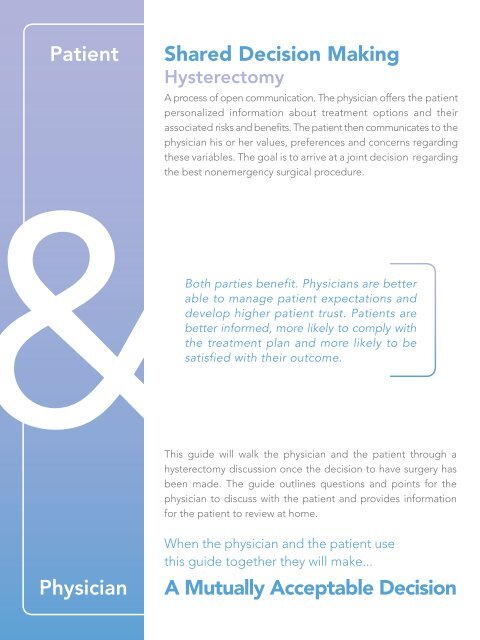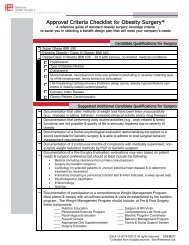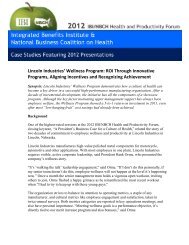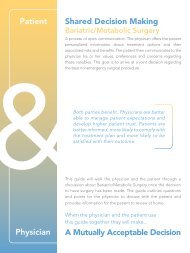Shared Decision Making Patient Physician A Mutually Acceptable ...
Shared Decision Making Patient Physician A Mutually Acceptable ...
Shared Decision Making Patient Physician A Mutually Acceptable ...
You also want an ePaper? Increase the reach of your titles
YUMPU automatically turns print PDFs into web optimized ePapers that Google loves.
<strong>Patient</strong><br />
<strong>Shared</strong> <strong>Decision</strong> <strong>Making</strong><br />
Hysterectomy<br />
A process of open communication. The physician offers the patient<br />
personalized information about treatment options and their<br />
associated risks and benefits. The patient then communicates to the<br />
physician his or her values, preferences and concerns regarding<br />
these variables. The goal is to arrive at a joint decision regarding<br />
the best nonemergency surgical procedure.<br />
Both parties benefit. <strong>Physician</strong>s are better<br />
able to manage patient expectations and<br />
develop higher patient trust. <strong>Patient</strong>s are<br />
better informed, more likely to comply with<br />
the treatment plan and more likely to be<br />
satisfied with their outcome.<br />
This guide will walk the physician and the patient through a<br />
hysterectomy discussion once the decision to have surgery has<br />
been made. The guide outlines questions and points for the<br />
physician to discuss with the patient and provides information<br />
for the patient to review at home.<br />
<strong>Physician</strong><br />
When the physician and the patient use<br />
this guide together they will make...<br />
A <strong>Mutually</strong> <strong>Acceptable</strong> <strong>Decision</strong>
Table of Contents<br />
For the <strong>Physician</strong><br />
• Put Your <strong>Patient</strong>’s Mind at Ease<br />
• Explain the Diagnosis<br />
• Describe the Procedure<br />
• Provide Complication Data<br />
• Discuss Quality of Life Implications<br />
• Prepare Your <strong>Patient</strong> for<br />
Surgery and Recovery<br />
• Benefits of Minimally<br />
Invasive Hysterectomy<br />
For the <strong>Patient</strong><br />
• Feel Good about Your <strong>Decision</strong><br />
• Understand Your Diagnosis<br />
• What Surgical Approach<br />
Should You Consider?<br />
• Know the Complications<br />
• Recovery after Surgery<br />
Official Recommendations<br />
Informational Websites<br />
Ask Your Surgeon Questions<br />
References<br />
Note: Click on any of the content contained in the Table of Contents to link directly to that section.
For the <strong>Physician</strong><br />
Put Your <strong>Patient</strong>’s Mind<br />
at Ease<br />
Hysterectomy is one of the most common<br />
surgeries among women, second only to<br />
C-sections. 1 Still, because of the intimate<br />
nature of the procedure and the conflicting<br />
emotions it may raise, many women feel<br />
uncomfortable talking about it.<br />
֏֏<br />
You can put your patient’s mind at<br />
rest by inviting her to participate in<br />
the decision-making process and<br />
objectively describing her options<br />
based on her personal concerns.<br />
֏֏<br />
<strong>Patient</strong> education materials and decision<br />
aids, many of which are available<br />
online, can help facilitate the process.<br />
Explain the Diagnosis<br />
֏֏<br />
Does your patient understand her<br />
diagnosis?<br />
• Explain what is causing her<br />
symptoms and why she may be<br />
a candidate for hysterectomy<br />
֏֏<br />
Have you considered all less invasive<br />
options, such as hysteroscopic or<br />
laparoscopic myomectomy, uterine<br />
artery embolization, endometrial<br />
ablation, pelvic floor repair or<br />
medical management?<br />
֏֏<br />
If there is an option, explain its<br />
benefits, risks and success rates. If<br />
there isn’t an option, explain why.<br />
Describe the Procedure<br />
֏֏<br />
Describe the Types of Hysterectomy<br />
• Total Hysterectomy<br />
• Partial or Supracervical Hysterectomy<br />
• Radical Hysterectomy<br />
• Bilateral Salpingo-oophorectomy<br />
Indicate which type you recommend for<br />
this patient and why. Discuss the potential<br />
impact on the patient’s current and future<br />
quality of life, e.g., will hysterectomy<br />
invoke menopause? Will the cervix remain<br />
or not, and what are the implications?<br />
<strong>Patient</strong>s may not understand that<br />
hysterectomy can be performed using<br />
different surgical techniques. Discuss the<br />
types of procedures:<br />
• Total Abdominal Hysterectomy (Open)<br />
• Vaginal Hysterectomy<br />
• Laparoscopically Assisted Vaginal<br />
Hysterectomy<br />
• Total Laparoscopic Hysterectomy<br />
• Laparoscopic Supracervical<br />
Hysterectomy<br />
Explain to your patient why she may<br />
or may not be a good candidate for a<br />
minimally invasive procedure (MIP). In<br />
general, minimally invasive surgery is<br />
preferable unless there are other factors<br />
present that may interfere with its safety<br />
and efficacy, such as obesity, adhesions<br />
from earlier pelvic surgery or underlying<br />
medical conditions. Sometimes an MIP<br />
may have to be converted to a TAH due<br />
to these or other factors, such as an<br />
inability to visualize organs adequately or<br />
bleeding problems during the procedure.<br />
Provide Complication Data<br />
֏֏<br />
Make sure your patient is aware of<br />
the potential for complications during<br />
surgery, such as adverse reactions to<br />
medications, problems with anesthesia,<br />
problems breathing, bleeding, blood<br />
clots, inadvertent injury to organs and<br />
vessels near the uterus and even death.<br />
֏֏<br />
Put these into perspective for her based<br />
on her own medical condition.<br />
Discuss Quality of Life<br />
Implications<br />
֏֏<br />
Ask about your patient’s lifestyle,<br />
occupation, normal activities, family,<br />
childbearing status, medical coverage<br />
and any other non-medical factors that<br />
may influence the decision.<br />
֏֏<br />
Ask about personal concerns regarding<br />
the hysterectomy procedure: feelings<br />
about recovery time, cosmesis, return<br />
to work and caring for family and other<br />
obligations.<br />
֏֏<br />
Address any personal concerns<br />
regarding the hysterectomy procedure:<br />
• effects on sexuality and sexual<br />
activity<br />
• effects on bladder function<br />
• psychological effects<br />
• other quality of life questions<br />
Prepare Your <strong>Patient</strong> for<br />
Surgery and Recovery<br />
֏֏<br />
Explain what your patient can expect<br />
after the surgery in terms of:<br />
• recovery time<br />
• pain<br />
• limitations on activity<br />
• resumption of normal activities,<br />
including work and intercourse<br />
Benefits of Minimally Invasive Hysterectomy<br />
Minimally invasive hysterectomy (VH, LAVH, TLH and LSH) is the preferred approach<br />
because of its proven benefits when compared to an open procedure.<br />
• Less major bleeding 2<br />
• Fewer post-op infections 2, 3<br />
• Fewer complications 2, 3<br />
• Shorter length of stay 2, 4<br />
• Quicker return to normal activities 4<br />
• Quicker return to work 4<br />
• Less scarring<br />
• Comparable or lower cost 2, 4
<strong>Shared</strong> <strong>Decision</strong> <strong>Making</strong><br />
Hysterectomy<br />
For the <strong>Patient</strong><br />
<strong>Physician</strong> Provides<br />
Treatment Options<br />
Risks and Benefits<br />
Experience and Skill<br />
<strong>Mutually</strong><br />
<strong>Acceptable</strong><br />
<strong>Decision</strong><br />
<strong>Patient</strong> Provides<br />
Personal Preferences<br />
Values and Concerns<br />
Lifestyle Choices
For the <strong>Patient</strong><br />
Feel Good about Your <strong>Decision</strong><br />
The prospect of having a hysterectomy can be daunting,<br />
but knowing you are not alone may help. One in three<br />
American women will have had a hysterectomy by the<br />
age of 60. 1 The best way to prepare for this surgery is to<br />
learn as much as you can and discuss your questions and<br />
concerns with your doctor. You should feel confident that<br />
you and your doctor have explored all your options, that<br />
you understand everything fully and that together you are<br />
making the decision that is best for you.<br />
Understand Your Diagnosis<br />
Hysterectomies are performed to treat many medical<br />
conditions. Be sure you understand the nature of your<br />
condition and how a hysterectomy would treat it.<br />
Endometriosis — growth of the uterine lining cells outside<br />
the uterus, in or on the ovaries or in the fallopian tubes;<br />
causes pain, cysts, scarring and infertility<br />
Uterine fibroids — benign tumors that grow in the walls of<br />
the uterus; causes excessive pressure, pain and bleeding<br />
Uterine prolapsed — the uterus is normally held in place<br />
by a web of muscles and connective tissues that act like a<br />
hammock; these shift and move into the vagina when weak<br />
or damaged<br />
Ovarian, uterine or endometrial cancer — abnormal<br />
cell growth in one of these organs; removal is the typical<br />
treatment to stop the spread of the cancer<br />
What Surgical Approach Should<br />
You Consider?<br />
Your physician has likely recommended a type of<br />
hysterectomy based on your medical condition and the<br />
non-medical considerations you have shared. These<br />
procedures are different based on the reproductive<br />
system organs that are removed during the surgery.<br />
Total Hysterectomy<br />
— removes the uterus and cervix<br />
Know the Complications<br />
All surgeries carry some risk. These will depend on your<br />
medical condition, age and the experience of your<br />
surgeon. Minimally invasive hysterectomies have been<br />
associated with a lower risk of postoperative infection, less<br />
pain and a faster recovery. 2–4 Abdominal hysterectomy has<br />
a greater potential for muscle injury and a postoperative<br />
incisional hernia.<br />
֏֏<br />
Typical complications include:<br />
• Adverse reactions to medications<br />
• Breathing problems<br />
• Blood clots<br />
• Death (rare)<br />
• Problems with anesthesia<br />
• Bleeding<br />
• Inadvertent injury to organs and vessels<br />
near the uterus<br />
Recovery after Surgery<br />
Your recovery will be dependent on the type and route<br />
of the hysterectomy you undergo.<br />
Days in<br />
the hospital<br />
Weeks of<br />
recovery<br />
Scarring<br />
Vaginal<br />
Hysterectomy<br />
Laparoscopic<br />
Hysterectomy<br />
Abdominal<br />
Hysterectomy<br />
0 to 3 4 0 to 3 4 3 to 5 4<br />
4 4 6<br />
No external<br />
scar<br />
Minimal<br />
scarring<br />
4-6 inch<br />
scar<br />
Ask your physician if the procedure you are having<br />
will invoke menopause. Ask your doctor if you should<br />
continue having annual pap smear tests. It’s also<br />
important to know what symptoms are typical.<br />
Partial or Supracervical Hysterectomy<br />
— removes the uterus but preserves the cervix<br />
Radical Hysterectomy<br />
— removes the uterus, cervix, upper part of the<br />
vagina and supporting tissues and lymph nodes<br />
Bilateral Salpingo-oophorectomy<br />
— performed in combination with hysterectomy to<br />
remove the ovaries and fallopian tubes<br />
Talk to your <strong>Physician</strong> and Surgeon.<br />
Become an active partner to develop the surgical plan that’s right for you.
Official Recommendations<br />
The American Congress of Obstetricians and Gynecologists (ACOG) issued a Committee<br />
Opinion in 2009 that examined evidence on the route of hysterectomy for benign<br />
(noncancerous) disease. The Committee recommended that vaginal hysterectomy surgery<br />
be considered the route of choice, with laparoscopic hysterectomy also considered a viable<br />
alternative to abdominal surgery. The Committee Opinion lists the strengths and weaknesses<br />
of each approach and cites evidence. 5<br />
It is the position of The American Association of Gynecologic Laparoscopists (AAGL)<br />
that most hysterectomies for benign disease should be performed either vaginally or<br />
laparoscopically and that continued efforts should be taken to facilitate these approaches.<br />
Surgeons without the requisite training and skills required for the safe performance of<br />
VH or LH should enlist the aid of colleagues who do, or should refer patients requiring<br />
hysterectomy to such individuals for their surgical care. 6<br />
Informational Websites<br />
www.smarterpatient.com/hysterectomy<br />
www.aagl.org<br />
www.acog.org<br />
www.hystersisters.com<br />
www.surgeryoptions.info
Print this page and take it with you to your appointment with the<br />
surgeon. This will ensure you receive helpful information to make<br />
an informed decision.<br />
Ask Your Surgeon Questions<br />
Never be afraid to ask questions if there is something that you don’t<br />
understand. In addition to the topics covered here, you should know that<br />
minimally invasive surgery requires special training and expertise.<br />
You Should Feel Free to Ask Your Surgeon:<br />
• How many minimally invasive hysterectomies have you performed?<br />
• How long have you been doing these surgeries?<br />
• How many of each procedure have you done?<br />
• What type of minimally invasive training have you had?<br />
• How long do you expect my hospital stay to be?<br />
• How long do you expect my recovery to be?<br />
Other Questions/Concerns I Have
References<br />
1. Centers for Disease Control and Prevention: hysterectomy surveillance — United States;1994–1999.<br />
2. Warren L, et al. Open abdominal versus laparoscopic and vaginal hysterectomy: analysis of a large United States payer measuring quality and cost of care.<br />
J Minim Invasive Gynecol. 2009;16(5):581–88.<br />
3. Brill A, Ghoush K, Gunnarsson C, Rizzo J, Fullum T, Maxey C, Brossette S. The effects of laparoscopic cholecystectomy, hysterectomy and appendectomy<br />
on nosocomial infection risks. Surg Endosc. 2008;(4):1112–8.<br />
4. Roumm AR, Pizzi L, Goldfarb NI, Cohn H. Minimally invasive, minimally reimbursed? An examination of six laparoscopic surgical procedures. Surg Innov. 2005;12;261.<br />
5. ACOG committee opinion no. 444: choosing the route of hysterectomy for benign disease. Obstet Gynecol. 2009;444(5):1156–1158.<br />
6. AAGL position statement: route of hysterectomy to treat benign uterine disease. J Minim Invasive Gynecol. 2010.<br />
©2011 Ethicon Endo-Surgery, Inc. All Rights Reserved. DSL 10-1324.EV









